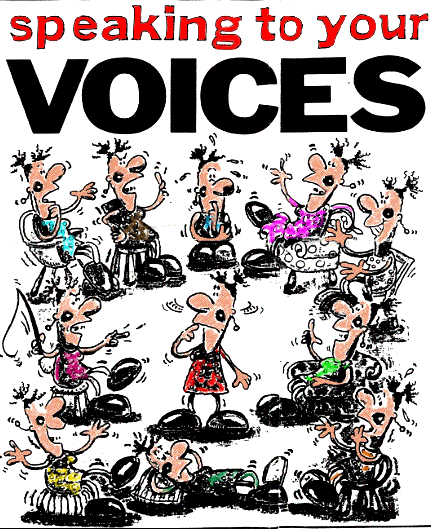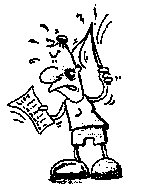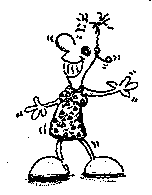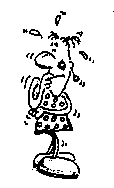Voice Dialogue, a Tool for Transformation
Voice dialogue is indeed a fantastic tool for self-dicovery, exploration
and transformation. It is a technique which permits us to find a shortcut
to our inner dimensions, and enables us in a straightforward way to contact
and begin a dialogue with our inner selves. This process is transformational,
as we'll get to know our inner territory, mapping it step by step, as we
discover parts of ourselves of which we were unaware, but which nonetheless
have a tremendous positive or negative power on us. The result of using
Voice Dialogue in an appropriate way will be in greatly increased awareness,
and an attitude of openness and honesty in the relationship we have with
ourselves.
I have chosen the following report by AMANDA JONES (© Here's Health,
october 1991) to give you an overview of the main ideas and concepts of
Voice Dialogue. (Having been published in 1991, the article does not inform
about the latest development which you'll find out soon enough if you gain
an interest for the subject, which is my purpose and hope in making this
web page.) Please check out other web sites indicated at the bottom of
this page.

The "real" you is often hard to accept, but it won't
go away. Once we can understand the influence that our "inner voices" have
on us we can deal better with conflict, unfuifillment and vulnerability.
In the space of a day we can slip in and out of a variety of roles - from
worker. to mother, to friend, to lover - each of which requires different
qualities. From an early age we use roles as a rope to help us climb up
a ladder of acceptance in the world. Shakespeare said: "All the world's
a stage ... and one man in his time plays many parts." We are all actors
in our own way, and life is a stage of sorts which is watched by an audience
of people we love. people we work with, and people we will never know.
Professional actors can convince us so completely that they are actually
the part they are playing that we forget that they learnt the lines of
a scriptwriter, were given guidance by a director, and, most importantly,
that they are free to step away from their persona.
Unlike the actor, we tend to do two things. We lock into a particular part
and are unable to free ourselves from it, even when the curtain has closed
and the audience gone home. Or, we try to play all the parts, flitting
- with minimal control - from hero to persecutor, victim to villain. Both
of these options are crippling.
Instead of hearing a director's words of guidance instead of knowing when
to stop or when to change roles, our ears are full of conflict from within.
Psychologists have recognised for many years that different parts exist
within us. These theories have been expounded by the likes of Carl Jung,
the psychoanalyst who talked of the common archetypes and psychological
instincts within us all. Yet, because comparatively few people enter psychotherapy,
it has been hard to use these concepts constructively - until now.
Two American psychologists, Dr Hal Stone and Dr Sidra Winkelman (now Sidra
Stone) (both former Jungian analysts) offer a bridge between the realm
of psychological theory and the reality of our day to day lives, where
we are acting furiously on our different stages. They have published several
books - of which "Embracing Our Selves" and "Embracing Each Other" (for
a complete review of their books, click
here to connect to Hal and Sidra's web site) - which offer a fascinating
insight into the amazing army of sub-personalities which speak through
us.
The "voices" are so easy to recognise that it is impossible not to listen
to what Stone and Winkeiman have to say about them. And they form a formidable
army - the critical voice, the pusher, the pleaser, the peacekeeper, the
perfectionist, the rational parent, the do-nothing, the rebellious child
(and these are only the obvious ones).
Reading what Stone and Stone perceive to be the motivating forces behind
these parts is the beginning of understanding why so many of us seem to
spend so many of our waking hours in conflict, not just with other people,
but within the stage of our heads. As the pages turn, examples are given
of situations we have all been in, mistakes we have all made and regretted.
But the purpose of the books, and this article, is not simply to introduce
you to the voices, it is to offer some solid advice to help us recognise
the loudest voices and listen to the quietest, to interpret their language,
which can be muddling and deceptive. The books are a preventative prescription
- for they encourage us to listen, to really listen, to which part is speaking
through us when we open our mouths. How often have we all said "I don't
know what got into me"? The more accurate analysis is really, "I'm not
sure which part of me did or said that". Stone and Stone's ideas shed light
on not only "who" did the dirty deed, but also on "why" they did it.
We may all think we are aware, and in control, of the communication taking
place within the confines of our minds. After all, if we are maintaining
a good job, involved in a reasonably happy relationship, social, and an
active member of our families, then we must be doing something right. But
behind this facade of success. many of us nurture a nagging fear that if
people really know what we were like... for some this fear is all-pervading,
for others it flits in and out nf our consciousness. Would we still have
friends, a job, a relationship, if we didn't keep an iron grip on the "unacceptable"
parts of our personalities? Unfortunately, this "control" is anything but.
As Stone and Stone explain, these denied, dishonoured parts of ourselves
are the inner "voices" that can create real havoc in our lives and tie
up vast amounts of our energy, leading to an inexplicable sense of dissatisfaction,
un-ease and ill-health.
In order to explain their theories it is necessary to go back to our childhood
and our upbringings. Stepping back in this way is important. Metaphorically
our upbringing and parental conditioning is like the work of the scriptwriter
- without whom there would be no play. And without our pasts there would
be no parts for us to play.
Dr Stone explains: "When a baby enters the world it is completely vulnerable
and dependent on other humans. But, as the months go by, the instinctive
need to survive soon encourages the infant to find ways to master the environment,
some measure of control needs to be found and the personality has to develop
a way of protecting this vulnerability. "The key word here is 'protecting"
- the development of the personality is unable to eradicate the core vulnerability
- it may clothe it in many guises, but the body remains the same. In the
same way we cannot vanquish our vulnerability.
Stone continues. "Powerful people think I'm crazy when I tell them they
have a vulnerable child in them. It doesn't go away just because they ignore
it, but it will make itself known in other ways. For example, if a man
is very powerful and disowns his vulnerability, one of his children may
be weak and vulnerable, or he'll have somebody vulnerable working for him
whom he just can't fire. He would be wrenching something from himself if
he extracted himself from these situations."
The danger is that, unless we become aware of this vulnerability, then
we will become its victim. "The inner child will ultimately find its parent.'
Stone-Winkelman says. 'either by forming desperate attachments to other
people, or by creating its own, within."
As therapists, Stone and Stone have seen time and time again that people
choose two ways to cope with their vulnerability. Firstly, we develop a
set of Primary Selves, or roles, through which we deal with the world.
They act as a circle of protection, a boundary, against pain. Secondly,
we expend vast amounts of energy disowning characteristics which threaten
our inner child. We may then "project" them onto other people - the ones
who irritate us, who are continually getting things wrong - the people,
sometimes whole races, whom we may actively hate and/or fear.
Both of these methods have their disadvantages. Our Primary Selves can
become too strong, and stop us living fulfilling lives. They may prevent
us from forming close attachments just to avoid potential pain, or they
can be too weak, allowing us to be a constant victim. Disowning characteristics
we don't like pushes them underground, into the sphere of the unconscious,
where they operate beyond our control. Often we are oblivious to both the
energy our disowned parts possess, and the impermeability of our Primary
Selves.
As children we grow up quickly realising that there is a responsive audience
watching us (in the guise of the family), and we learn to act and perform
for them. Dr Stone-Winkelman says. "The child creates key parts to take
care of it - the Primary Selves - they are by no means all of us but they
are the parts which other people recognise as being our personality."
A popular triangle is: the Pleaser, born once the baby learns that its
spontaneous smile pleases the mother; the Pusher, who quickly learns that
an element of force is needed in order to get what it wants; and the Critic,
who acts as a tireless judge of other people's behaviour, and - more significantly
- our own.
Stone-Winkelman views the Primary Selves as "utterly essential", but warns
against becoming over-identifled with them. "If this happens you lose the
ability to step back and make choices. If the Pusher is too strong it just
won't allow you the time to stop and think, it will shout at you that there's
too much to do. too little time."
Under the umbrella of these Primary Selves. a multitude of other parts
huddle, waiting to make their appearance. But the character who holds the
umbrella is, according to Stone, the Protector/Controller. An optimum performance
can only be teased out of an actor with the help of a skilful director;
likewise the parts we possess need con- trolling. We all have our own director,
a pivotal and invisible part that provides us with support and protection
- the Protector/Controller. "It provides an essential balance." Stone says,
"and tries to ensure our safety by making sure that we are accepted by
others, by monitoring our behaviour, preventing us from acting foolishly."
It does this by upholding the Primary Selves, by judging the weather to
decide when to put up the umbrella.
Stone and Stone explore the less obvious parts in fascinating detail. These
are parts which we can fall in and out of, often with alarming speed, and
they tend to emerge when the emotional stakes are high. Who is it that
lies to avoid hurting someone, who flies into rages quite out of proportion
to the cause? Who bosses a partner around. avoids arguments, lacks confidence?
If we are unable to understand our "selves", it is no wonder we spend so
much of our time feeling misunderstood. These examples are more than transient
feelings - they may come and go, but the chances are that they do so with
monotonous regularity. They become patterns which we are locked into and
which have a horrible habit of strangling relationships - how often does
jealousy end in separation, or the smothered child end up rejecting the
overpowering parent?
Stone and Stone call these destructive scenarios "bonding patterns", which
we lock into and then forget how to get out of. "The catalyst for all negative
bonding patterns is the activation of the disowned vulnerability in two
people." Stone-Winkelman observes.
Some relationships are one big bonding pattern - a father-daughter, mother-son
energy bond often seems to occur in marriages, for example. There is nothing
"wrong" with that bonding and it may even make for a very happy relationship
- but it can also, be limiting and stifling, especially if one partner
begins to see that there are other aspects to his or her self that are
not being expressed.
A husband who lets himself be "mothered" by his wife may eventually react
just like the smothered child by rejecting the bewildered "parent". The
answer, in Voice Dialogue terms, would be for the man to develop his own
ability to be a "mother" - to express his nurturing abilities, which may
be symbolised by some sort of "Inner Housewife"! ' First of all he needs
to acknowledge that side of himself: denied selves require a lot of energy
to hold them down - sometimes the dam bursts. From the woman's point of
view, she may need to allow her strong, forceful "Protector" to now and
then emerge. If she doesn't, a similarly baffled husband-father may find
himself with a resentful, rebellious "daughter'-wife who walks out despite
his best efforts to provide her with a house, car and security. That's
the power of denied, buried 'voices'.
Understanding why we disown parts is, according to Dr Stone, a vital step.
"Think of someone whom you really dislike and judge. Now look at yourself
- your reaction will be a direct representation of a disowned self. If
you loathe someone because they are flirtatious, or overtly sexual, then
ask if you allow yourself ever to flirt, if not - ask why not. On the other
hand, there are people who we over-value emotionally. They are also examples
of a part of ourself we have disowned. "The danger here is that if we suppress
the feeling rather than admit it exists, it can blow out of proportion
and be destructive.
Stone says, "So long as a self is disowned within us, we will continue
to repeatedly attract that particular energy into our life. This is the
paradox of disowned selves: we are drawn to the very people who carry these
"unacceptable" qualities for us. This holds true whether the "unacceptable"
qualities are good or bad: it applies to the people we overvalue as well
as those we despise." But there is hope in-Stone's foreboding - we just
have to start looking at people within our lives to whom this may be applicable,
and assimilate and analyse the reactions they evoke in us.
Stone and Stone's work was originally created as a tool to use in a therapeutic
situation and, as such. its implications expand way beyond their books.
But for practical purposes their introduction to our "parts" can help us
enormously in our day-to-day lives, resolving petty conflicts or even major
power struggles within relationships. In a Voice Dialogue session, a therapist
may explore the problem area with you and will then ask to speak to a particular
"voice". You will move to a different chair, or place in the room; often,
a surprisingly different-sounding "you" will then talk - you will probably
adopt slightly different mannerisms and rhythm and tone of speech; you
may even feel emotionally very different.
The key is to be able to step back and listen to yourself. This detachment
gives one a sense of safety, a rock to stand on and look, a chance to look
at the situation with a degree of objectivity - a place of rest. It's called
Voice Dialogue - and that's the point: to be able to get all your selves
speaking to each other, so that you honour all your different needs and
do not continue to sabotage yourself and invite unintentional chaos into
your life. Then we can step down, speaking through whatever part we choose
- for we are free to choose.
Dr Hal Stone and Dr Sidra Stone's Voice Dialogue technique is widely used
in the United States. Australia, Holland, and other European countries.
Training courses are held which put the theory of parts into the practice
of actually talking with them, in a counselling situations.
Books are generally available in major bookshops and specialist booksellers.
For details about books and tapes, click
here to get to Hal and Sidra's own site.
THE PUSHER

The Pusher is easy to spot: it stands with a whip in one band and a to-do
list in the other. When working constructively it enables us to get things
done with speed and efficiency, but when it assumes too much power, our
physical bodies will often pay the price in the form of heart attacks,
migraines and exhaustion.
- as you cross one thing off the top of your list of things to do, another
is added to the bottom.
- you cannot rest or relax without feeling that you are waisting your time
(the Pusher loves to interrupt moments of peace and quiet).
- you have a pile of books by your bed which you feel you must read, none
of which are fun.
- your Pusher tells you to do more exercise, take more vitamin pills...
POLAR OPPOSITE: The Do-Nothing can motivate this part to do nothing.
THE PLEASER

If your Pleaser is out of control you spend most of your day bending over
backwards to help others. The pleaser is very sensitive to the moods and
needs of others, but it can smother them, or make them feel perpetually
beholden.
- you are constantly changing your opinions and plans to please othres.
-you still find yourself listening to a friend's problems when you've problems
of your own and are exhausted.
- you cannot say no when someone asks you a favour.
- you find yourself being taken for granted by "unappreciative" friens
and family.
- you ignore your own needs, repeatedly.
POLAR OPPOSITE:
The Selfish Taker - this part has no compunction about taking mercilessly,
exploits the Pleaser.
THE CRITIC

The Critic collaborates perfectly with the Pusher. It fhas an inherent
intuition of where our weak spots are and then attacks with painful precision.
There is often no place to hide. The Critic creates a cornerstone of guilt
which so many people build their lives and relationships around.
- your're constantly thinking your're "too" anything: too fat, too thin,
too boring ...
- its language is comprised of of certain favourite words: you can't, you
should, you ought, you never.
- you feel hopelessly inadequate against friends and colleagues, as if
you can't compare.
- you pleasure is always restrained by remebering the bad things.
- you are unable to feel natural emotions without thinking you are criticising
your response and motives.
POLAR OPPOSITE:
There isn't one. The Critic, when out of control, has amazing energy and
tenacity. No opposite could oppose it.
THE INNER CHILD
The Inner Child carries our vulnerability - as such it oscillates between
two extremes. It has the capacity to feel the deepest love for another
ynd yet, because of this capacity, it lives in constant fear of abandonment.
As a protection most of us try to do just that - abandon it and extract
ourselves from situations where the emotional stakes are dangerously high.
The Inner Child can be ignored, abused, and rejected, but it cannot ever
be lost - it is like a shadow, always there but often out of sight.
If the Inner Child is not protected the "victim" will emerge; if it is
protected too well, an emotional vacuum will take its place.
TYPICAL FAMILY
BONDING PATTERNS
Nurturing Mother / Selfish Daughter If the mother gives too much it may
bring out the selfish and thoughtless opposite in her children. By disowning
her own selfishness, the mother unwittingly transfers it onto the children.
Successful Father / Spiritual Son If a father has always placed a tremendous
emphasis on material wealth and business success, a son could go the other
way on a non-material spiritual quest.
Rebellious Sibling / Peacekeeper In family situations, if one child is
disruptive, another may assume the role of keeping the peace and dissipating
potentially difficult situations.
Strong Mother / Dependant Child A parent who needs to be depended on, may
have had their own need neglected in their childhood - they overcompensate
by becoming the pivotal point in a child's life whose development is hindered.

Other
Voice Dialogue pages on this site

Other
Voice Dialogue sites:

Training
in Europe:
Britain:
Transformational Trainings : Toni Tye & Lee Preisler
Dove Villa 99 Radford Road - Leamington Spa - Warwickshire CV31 1JZ
- email: [email protected]
- Phone & Fax: (++44)-1926-882494
France:
Diana L. Smith, PARIS, email: [email protected]
, Tel: ++33-1-45 85 0338, Fax: ++33-1-44 23 7160
for worshops all over Europe.
Germany:
Artho Wittemann, Veeta Gensberger, Voice Dialogue Centre, Fallmerayerstrasse
36, Munchen D-80796
49-89-308-5846 Phone and Fax
Netherlands:
Voice
Dialogue (Netherlands)
Robert
Stamboliev, author of "The Energetics of Voice Dialogue",
Voice Dialogue trainer, teaching mainly in the
Netherlands and France, but also in other countries, such as Germany,
Norway and last year for the first time in Russia.
Sweden:
Frans Kocken and Kali, Voice Dialogue Instituet, Nytorget 8,
Stockholm 11640, Sweden
(++46)-08-640-8926
Switzerland:
L'atelier
du Dialogue Interieur, Contact Adelheid OESCH Cité-Derrière
8 CH-1005 Lausanne Tél. (++41) 021-3231501
Fax. (++41)-021-3206227 email: [email protected]
Australia:
Robin and Paul Gale-Baker, Latona Consulting, P.
O. Box 18, Rosanna, VIC 3084, Australia
Phone and Fax (++61)-3-9459-2927 email: [email protected]
, web page: http://www.ozemail.com.au/~latona/
Astra Niedra, P.O. Box 979, Glebe NSW 2037, Australia, Phone and Fax
++61-2-9552 1437, email: [email protected]
List to be updated (with your help! please email events and coordinates
of other trainers) Last update: December
12 1997

 ..please
email me for any exchange on the subject. I'm looking for a Voice Dialogue
partner in the Luxembourg area, to swap sessions, and for joined exploration:
[email protected]
..please
email me for any exchange on the subject. I'm looking for a Voice Dialogue
partner in the Luxembourg area, to swap sessions, and for joined exploration:
[email protected]




![]()